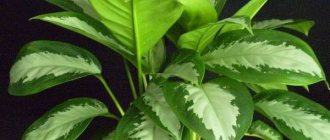The plant Streptocarpus is a member of the Gesneriaceae family. This genus includes more than 130 species. In nature, such a plant can be found in Asia and Africa. This genus is represented by shrubs and herbaceous plants, which, depending on the species, can be either annuals or perennials. Streptocarpus began to be cultivated at home in the first half of the 19th century. This plant is a rosette plant, and its stem is short. The shape of the heavily pubescent leaf blades is broadly lanceolate, their color can be green or variegated. The flowers growing from the axils of the leaves can be single or collected in bunches of 2 pieces. This plant was named streptocarpus because of its fruits, as their shape is similar to a long spiral capsule. Flowering begins in spring and ends in autumn. In winter, the flower has a short dormant period, but the bush does not shed its leaves.
Streptocarpus, or Cape primrose
There are hundreds of varieties of Streptocarpus. All of them mainly grow in the southern part of the African continent (as evidenced by the popular name of the flower - Cape primrose), as well as in Central and Eastern Africa, including Madagascar and the Comoros Islands. They were imported to Europe about 150 years ago, but the real boom began at the end of the twentieth century, when breeding work began to develop new hybrids and varieties. Currently, flower growers can choose streptocarpus with large and small flowers, painted in the most incredible shades of white, blue, lilac, yellow, burgundy; they can be fragrant and odorless, with simple flowers and with wavy petals at the edges.
In nature, streptocarpus can be found in forests, on shaded rocky slopes and in rocky cracks.
Streptocarpus is the closest relative of Gloxinia and Saintpaulia (Usambara violets). The genus belongs to the Gesneriev family, representatives of which usually grow in the wild as epiphytes or lithophytes. Cape primrose is found in wooded areas and grows in moist soil and light shade. Some species can be found on shaded rocky slopes, on the ground, in rock cracks and almost anywhere seeds can germinate.
Streptocarpus got its name due to the shape of the fruit, twisted in a spiral. Literally, the word "strepto" means "twisted" and "carpus" means fruit.
Modern hybrids only vaguely resemble natural species
Plants of the genus Streptocarpus have two main forms: multileaf and unifoliate. The first, in turn, has a rosette shape. These are perennial plants and are the ones most often grown indoors. The flowers of modern hybrids usually have a diameter of three to several centimeters and consist of five petals.
The second form has only one leaf growing from the base. Many species are monocarpic, they bloom only once, and after setting seeds they die, giving life to new plants. Although some are also perennial, that is, after the leaf dies, the flower produces a new one from the base, and the old leaf blade dies.
Monocarpics bloom once, giving life to new plants after the death of the set seeds.
Streptocarpus flowers are 2.5–3.5 cm in diameter and come in a variety of colors, ranging from white and pale pink to purple and violet, with all sorts of color combinations. The buds are tubular, in appearance they somewhat resemble a bell, they can have smooth or wavy edges, simple or double, decorated with cloves or scallops. Large leaves have an elongated shape and a velvety surface. The fruits are pods with small seeds.
“In captivity” Streptocarpus grows well, blooms and sets seeds. If you create suitable conditions for the flower, it will bloom for quite a long time and very profusely, as flower growers say - “with a cap”. Reproduction of the plant at home is also not difficult; streptocarpus can be grown from seeds, leaves, and even from small fragments of the leaf blade.
Natural species of streptocarpus
Currently, botanists have identified more than 130 species of streptocarpus. Some of the most popular are:
- Streptocarpus rexii (S. rexii). The plant is stemless, its distinctive feature is long pubescent leaves, the length of which reaches 25 cm. The flowers of the royal streptocarpus are colored purple, and there are purple streaks inside the throat.
- Streptocarpus stem (S. caulescens). A plant whose stem grows up to 50 cm in height. Its downward-sloping flowers have a soft blue tint.
- Kirk's Streptocarpus (S. kirkii). The leaves and flower stalks of the ampelous plant reach 15 cm and have a drooping shape. The buds of a light purple hue are collected in umbrella inflorescences.
- Streptocarpus Wendlandii (S. wendlandii). The flower has one large oval-shaped leaf, the length of which reaches 0.9–1 m. The wrinkled and pubescent leaf blade is colored green on top, and reddish-purple below. Flowers with a diameter of 5 cm bloom from the axils of a long peduncle. Streptocarpus Vendlana reproduces exclusively by seed; after flowering it dies.
- Streptocarpus rocky (S. saxorum). The plant is perennial. Its distinguishing feature is its woody base. The leaf blades are small and oval in shape. The shoots are twisted at the ends. Small lilac flowers bloom in spring and summer.
- Streptocarpus primulifolius (S. primulifolius). The plant belongs to the rosette species. The stem grows up to 25 cm in height, up to 4 flowers bloom on it, the petals of which are decorated with all kinds of dots, streaks and strokes.
- Streptocarpus johannis (S. johannis). Rosette type with straight stem. The leaves grow up to 50 cm in length and their width is 10 cm. About 30 lilac-blue flowers bloom on the peduncle.
- Streptocarpus major (S. grandis). A single-leaf species, its single leaf blade is quite large, growing up to 40 cm in length and 30 cm in width. The stem rises 0.5 m; flowers of a light purple hue with a darker throat and a white lower lip bloom at its top.
- Streptocarpus cornflower (S. cyaneus). The stems of the rosette plant reach 15 cm. The flowers are painted in different shades of pink and grow two per stem, the middle of the bud is painted yellow, the pharynx is decorated with different dots and stripes of purple color.
- Streptocarpus white (S. candidus). The leaf blades of the rosette plant grow up to 45 cm in length and reach 15 cm in width; the texture of the leaf surface is wrinkled and velvety to the touch. The snow-white flowers are decorated with yellow stripes, the throat is decorated with purple dots, and the lower lip is decorated with red strokes.
- Streptocarpus glandulosissimus (S. glandulosissimus). The stem of a plant of this species grows up to 15 cm in length. The buds are painted in different shades from purple to dark blue.
- Streptocarpus primrose (S. polyanthus). The plant is a single-leaved variety. The leaf blade is densely pubescent and grows up to 30 cm in length. The flowers, about 4 cm in size, are painted in various shades of blue with a yellow spot in the middle.
- Streptocarpus Holst (S. holstii). The flower has fleshy stems, the size of which reaches 50 cm. The leaf blades have a wrinkled texture, they reach 5 cm in length. The buds are painted purple, and their base is snow-white.
Photo gallery: Streptocarpus species
The flowers of the royal streptocarpus are purple in color, with purple streaks on the throat
Streptocarpus Wendlana reproduces exclusively by seed
Small lilac flowers of Streptocarpus rocky bloom in spring and summer
The petals of Streptocarpus primulolifolia flowers are decorated with all sorts of strokes and dots
About 30 lilac-blue flowers bloom on the peduncle of Streptocarpus johanensis
The stem of Streptocarpus major rises 0.5 m; flowers of a light purple hue with a darker throat bloom at its top
Streptocarpus stem flowers have a soft blue hue.
Streptocarpus Kirka is grown as a hanging plant.
Collection varieties and hybrids of streptocarpus
Currently, breeders are doing a lot of work to create spectacular hybrids and varieties of streptocarpus. More than a thousand varieties of domestic and foreign selection are known; it is, of course, impossible to describe all of them in one article; we will present only a few of them.
- Streptocarpus with flowers of rich dark purple shades with a velvety surface of the petals - varieties Dracula's Shadow, Thunderous Overture.
- Flowers with a fantasy pattern of strokes of different shades on plants of the Himera Pedro and Tarjar's Roger varieties.
- Flowers with the finest mesh (“vein pattern”) look incredibly impressive. Among the varieties whose buds have a similar color include Victorian Lace, Maja, Lisica, and Spring Dreams.
- DS-Kaya's Heart is a variety whose flowers have a matte white underside.
- DS-Meteor Shower - with blue-white upper petals and a yellowish-blue border around the edge.
Varietal diversity of streptocarpus in the photo
The Dracula's Shadow variety has magnificent flowers with velvety petals
Thunderstorm Overture - an excellent variety of domestic selection
The Himera Pedro variety has delicate flowers of different shades of lilac
Streptocarpus Tarjar's Roger has very showy flowers
Streptocarpus Victorian Lace flowers look like bright lace
Petals of Streptocarpus variety Maja are decorated with purple streaks
Lisica variety has wavy edges of petals
Spring Dreams - a variety of streptocarpus with incredibly delicate flowers
The petals of flowers of the DS-Kaya Heart variety are decorated with a mesh of dark veins
DS-Meteor Shower with small, bright colors and dark rays from the throat
Description
The homeland of streptocarpus is the island of Madagascar, as well as South Africa.
Under natural conditions, more than 130 plant species grow at altitude, on mountain slopes, in tropical and subtropical forests. In summer, for comfortable growth, the plant needs a temperature within +20...+25˚С, and in winter not lower than +14˚С. Streptocarpus is a herbaceous plant with a shortened stem. It grows not upward, but in breadth. Wrinkled and slightly drooping leaves can reach 30 cm in length, 5-8 cm in width, and the flower has a diameter of 4 to 9 cm.
A mature plant with many mature leaves may have about 100 flowers at a time.
The advantages of streptocarpus include:
- unpretentiousness: the plant does not require complex care;
- long flowering time: begins in spring and lasts until winter;
- additional lighting: it allows you to achieve flowering throughout the year;
- the plant looks great even during the dormant period.
The list may be longer, but even the listed advantages are enough to describe how magnificent the flower is.
Table: requirements for growing streptocarpus at home
| Season | Temperature | Humidity | Lighting |
| Spring Summer | +23–27 °C. Plants tolerate drafts well, but do not like heat. | Requires high humidity. This requires regular spraying with water at room temperature. However, it should be noted that water should not get on the leaves and flowers of the plant. Spray the air around the flower and install a humidifier nearby. In the summer you can arrange a shower (the flower responds well to the procedure), but you cannot immediately put it on the windowsill; first you need to dry the plant in the shade. | The lighting is diffuse. It is better to place it on the windowsill of a window facing East or West. In summer you can take it out onto the balcony or loggia, but shade the flower from direct sunlight. |
| Autumn winter | +18 °C. | Spraying once a week. If streptocarpus blooms, then droplets should be avoided on the flowers. | Requires additional illumination with a fluorescent lamp. |
Campanula is also distinguished by its unpretentiousness and abundant flowering. You can learn more about this flower from the material:
Possible problems
- Gray rot . If streptocarpus is watered excessively, it can be affected by gray rot.
- The buds turn brown . This happens when the room temperature is excessively high.
- The edges of the leaf blades turn brown . This can happen due to stagnation of liquid in the substrate or if the air humidity in the room is extremely low.
- Harmful insects . Most often, thrips, spider mites, scale insects, whiteflies and mealybugs settle on such a flower.
Problems of streptocarpus of a non-infectious nature. Exhaustion.
Caring for the "Cape primrose"
Streptocarpus is considered a non-capricious plant. All he needs is regular hydration and feeding.
Recent Entries
Lilac perennials that are beautiful, compact and do not crowd out other plants Why when buying seedlings you should not take the sellers’ word for it and how to determine the age of the plant using 3 signs Tomato seedlings have turned purple or whitish: why the color has changed and how to save the plants
Watering
Watering the plant should be done regularly. Please note that the flower does not tolerate excessive moisture and overdrying of the soil very well. The water for irrigation is pre-settled for 24 hours and watered along the edge of the pot. An hour after the procedure, it is recommended to drain excess moisture from the pan.
Optimal soil moisture can be determined by performing a simple test. Blot the surface of the peat substrate with a paper napkin. If there are small spots of moisture on it, then the substrate is sufficiently moistened. If the surface of the soil in the pot is shiny and has a black tint, then such soil is too wet for streptocarpus, and the red color of the peat indicates the need for watering.
Feeding streptocarpus
Fertilizers should be applied every one and a half to two weeks, using liquid preparations for flowering plants. This will significantly increase the growth of streptocarpus, accelerate the appearance of buds and strengthen the flower’s immunity, which will help protect it from pests and diseases.
Kemira Lux and Etisso fertilizers are excellent for feeding. The only condition is that the solution should be diluted in a concentration two times less than indicated in the instructions.
Flowering and dormant period
As a rule, streptocarpus bloom in late April - early May. During this period, they need good lighting, but they must still be shaded from direct sunlight, otherwise the leaves may wither or get burned. It is recommended to systematically remove wilted flowers and peduncles; this will stimulate the appearance of new peduncles.
To ensure abundant flowering, you need to remove faded flowers and peduncles.
Streptocarpus does not have a rest period as such. But in winter, in order for the plant to gain strength before flowering again, it needs special conditions. At this time, the flower is kept at a temperature of +18 ° C and the amount of watering is reduced.
To stimulate flowering, the plant must be replanted in the spring into a fresh substrate, adding horse compost to it. Old and long leaves need to be shortened to 4–5 cm, which will stimulate the appearance of new leaf blades. Once the flower has developed a good amount of green mass, it will be ready to bloom. Please note that in order to get more abundant and long-lasting flowering, it is recommended to break off the first peduncle.
Table: problems when growing streptocarpus
| What does the plant look like? | What is the reason? | How to fix the situation? |
| Streptocarpus leaves yawned. | Lack of moisture | Water the flower. |
| The leaves have turned yellow. | Nutrient deficiencies | Feed streptocarpus with complex fertilizer. |
| The tips of the leaves are dry. |
| Spray the air around the flower, being careful not to let drops of water fall on the leaves. Plant the streptocarpus by dividing the rosette into several parts. |
| A rusty coating appeared on the leaves. |
|
|
If a plant does not bloom with good care, then the reason lies in the aging of the foliage. Each leaf can produce no more than 10 peduncles.
Features of cultivation
Soil selection
The root system of streptocarpus is large, consisting of many small roots, growing in breadth. This property determines the choice of container for growing. Wide but low pots are suitable for the plant, the size of which should completely accommodate the roots, which will avoid rotting of the root system.
The best option would be to use ceramic, preferably without glaze, flowerpots. You can also use clay ones, but sometimes the roots grow into the walls of such vessels, which significantly complicates the process of replanting the plant.
It is better not to choose plastic containers for growing streptocarpus, as the root system will develop worse in them.
In nature, streptocarpus grows on light soils. Therefore, the soil for planting must be well permeable to air and water. If you choose from ready-made substrates, then a mixture for Saintpaulia is quite suitable. Plant development will noticeably improve if the mixture is diluted with high-moor peat. It will act as a leavening agent and fertilizer at the same time. The optimal pH of the soil mixture should be in the range of 5.5-7.
Those gardeners who want to prepare the soil for growing streptocarpus themselves can mix three components in equal proportions: peat, vermiculite and perlite. This combination will make planting and caring for the plant easier.
A mixture of peat, garden soil, charcoal, and sphagnum moss would also be a suitable option. The components should be taken in proportions 3:3:0.5:1. After preparing the soil mixture, it is imperative to sterilize it in a water bath for one and a half hours. This time will be enough for the complete destruction of pathogenic microorganisms and pests that can cause disease and cause the death of the plant.
It is important to know that these flowers are not planted in the garden.
Location and lighting
The plant grows well in artificial light. Sunny places and access to fresh air provide streptocarpus with conditions close to natural. The main thing is that the room where the plant grows is not too hot, but there should be high air humidity. It is in such conditions that wild species live.
During the hot period, the flower will feel most comfortable on western and eastern windows. On the northern side there will not be enough light, and on the southern side it will have to be protected from direct sunlight.
Intense heat and drafts are difficult for streptocarpus to tolerate. In the summer, you can take the plant out into the fresh air and bring it indoors at night.
To ensure year-round flowering, streptocarpus should be additionally illuminated with white fluorescent lamps. Daylight hours for these plants should last at least 12 hours. Streptocarpus should be placed at a distance of about 20 cm from the lamp. In the absence of an additional light source, the plants will remain dormant for 2-3 months.
Temperature, humidity, watering
The plant is thermophilic. The optimal ambient temperature for it is +22…+25˚С.
In winter, streptocarpus should be left in rooms where the temperature is maintained within +14...+15˚С.
As for watering, there should not be an excess of water: in nature, streptocarpus feed only on sedimentary waters. Excessive soil moisture can lead to root rot. Thus, in the period between waterings, the earthen lump should have time to dry out a little.
In order to understand how much moisture your plant needs, you should monitor the condition of the leaves, which begin to wither if there is insufficient moisture. After watering, their shape returns to normal.
When growing streptocarpus under artificial conditions, it is best to water it with rainwater. In the absence of such, filtered or simply settled tap water a little warmer than room temperature will do. The best option for watering is through a tray. Bottom watering should be done from time to time. But the main thing here is not to overdo it, so as not to cause the plant to rot.
High air humidity is required to maintain streptocarpus. Under no circumstances should the leaves be sprayed with water or wiped with a wet sponge. You just need to carefully humidify the air, avoiding moisture getting on the leaves. The plant feels comfortable next to moss or containers filled with wet pebbles.
Fertilizers and fertilizers
Streptocarpus should be fed with fertilizer every two weeks, but do it carefully, using ¼ of the recommended concentration of fertilizer for a flowering houseplant.
Streptocarpus needs potassium, phosphorus, and nitrogen in equal proportions. These substances promote leaf growth and ensure abundant and stable flowering. You can use ready-made liquid mineral fertilizers specifically designed for flowering plants.
Only completely healthy plants need to be fertilized.
Nutrients are added to pre-moistened soil.
In winter, when the plant is dormant, you can not feed it, limiting yourself to only scanty watering.
Transfer
In order to ensure long-term flowering, streptocarpus should be replanted annually in spring or summer into a new substrate rich in nutrients. In order for the leaves to be strong and large, fertilizer should be applied between transplants. During the transplantation process, it is necessary to properly prepare the earthen ball: it should be slightly moist, and the earth should not stick to your hands. If the soil is too dry, mechanical damage to the root system can be caused, which will affect the general condition of the plant.
When replanting streptocarpus, it is necessary to ensure that the petioles of the plant do not touch the substrate. To fix the position of the plant, a little sphagnum moss should be placed on the surface of the soil layer; it is allowed that it slightly covers the lower leaves of the streptocarpus.
Trimming
If streptocarpus has reached a large size and takes up a lot of space, large lateral leaves can be cut off. However, this is not advisable. The fact is that the abundance of flowering directly depends on the condition of the bush. Good flowering is due to healthy and strong leaves that nourish the flowers. Pruning leaves does not go without consequences, as the photosynthetic surface is reduced and the production of nutrients is reduced. Only infected parts of the plant, weak leaves and growing points, as well as faded flower stalks need to be removed.
Winter care
You need to start preparing streptocarpus for the winter period in advance, back in September. First, the flower is transplanted into new soil, which has an identical composition to the soil used to grow the plant. Old roots and leaves are partially removed, after which the streptocarpus is watered. No fertilizing is required in winter. The optimal temperature for wintering is about +15˚С. With the onset of the dormant period, watering the plant should be significantly reduced.
Table: flower protection from diseases and pests
| Disease/pest | Signs | Methods of disposal |
| Gray fungal rot | Fluffy grayish mold on the leaves, caused by the botrytis fungus, appears when there is excessive dampness and when kept in cool conditions. |
|
| Powdery mildew | Whitish coating on leaves, flowers and stems. |
|
| Aphid |
| Treat with an insecticide (Fitoverm, Akarin, Actellik). Carry out 2-3 treatments (according to instructions). |
| Weevil |
|
|
Photo gallery: diseases and pests affecting streptocarpus
A white coating on the plant indicates the appearance of powdery mildew.
When kept cool and too moisturized, the flower is affected by gray rot
The weevil gnaws leaves, causing damage to the plant
When infested by aphids, the leaves curl and become deformed.
Useful properties of streptocarpus
Streptocarpus is grown for decorative purposes. It looks good in any interior, not only during the period of abundant flowering. The rosette of young leaves also looks impressive. The plant is not toxic, but it also has few beneficial properties. Some fans use it in small quantities as a spicy seasoning.
Reviews from flower growers
I only recently, this summer, started growing streptocarpus. I bought leaves and now little babies are growing out of them. I bought some plants as small children. Some stand and bloom on the loggia - they like the cool. Some are under the lamps on the window (the window is also always open to the loggia .The main thing is not to overwater, otherwise they are very unpretentious! If they grow to flowering, they bloom constantly.
Deer https://forum.bestflowers.ru/t/streptokarpus-uxod-v-domashnix-uslovijax.109530/
Streps are beautiful, I fell in love with them at first sight, but when it came to the reproduction of existing children, I had to suffer.
But this probably makes me love them even more now)) For me it was problematic. In general, there are 3 options: propagation by seeds, dividing the bush and growing children from leaves. Nat31 https://irecommend.ru/content/zagadochnyi-tsvetok-streptokarpus-ukhod-i-razmnozhenie-strepsov-mnogo-mnogo-foto-moikh-lyubi
So I wouldn’t say that their flower is problem-free.
He is more demanding than many others. Well, watering is not difficult, it’s better to dry it out a little between waterings. Categorically does not like water getting on the leaves. Loves humid air, but, again, not too much. I'm not very painless with transplants. Transplanted plants take a long time to recover and get sick. Almost always, regardless of whether I divided the bush or replanted it entirely. Here you need to feel them. None of my other pets had such problems with transplantation (oh, no, there is also a silver peperomia, which is also very sensitive to transplantation - but with the rest everything is always ok) But even on a north window you can achieve flowering, and then it turns out so cheerful clearing: Natlli https://wap.romasha.forum24.ru/?1–18–0-00000011–000–0-0–1274589440
I grew my own streps from seeds.
(NK it seems, if necessary, I’ll look more precisely later). They germinate well and fairly quickly, but the seedlings are very small and weak and grow slowly. They categorically refuse to live without a greenhouse. They were finally removed from the greenhouse only 6–8 months after sowing. Picking noticeably accelerates the growth of young plants. They bloomed for me about a year and a half to two years after sowing. I also propagated them using cuttings using an “unconventional” method - I simply left them in a damp, hermetically sealed bag. Natali https://homeflowers.ru/yabbse/index.php?showtopic=3173
Reproduction methods
The propagation process of streptocarpus can be carried out generatively using seeds and vegetatively using plant parts.
Cuttings
Propagation by leaf cuttings begins with cutting cuttings with good leaves using a sharp knife. Scissors cannot be used for trimming, as this will damage the tissue and disrupt the structure of the cells.
When pruning, make an oblique cut and dry the cut leaves for a couple of hours, then powder the cut area with charcoal. For these purposes, you can use activated carbon purchased at a pharmacy. In order for the process of emergence of a new plant to be faster, the top of the leaf is cut off.
It is recommended to cut off the lower leaves, as they contain a greater supply of nutrients.
The cuttings should be rooted in a loose substrate. Drainage is poured into the bottom of the container, followed by a low-nutrient substrate. The cuttings are planted at an angle and the ground is watered. The plant can be sprayed with an antifungal drug for prevention. The cutting is covered with a transparent plastic bag and left in a warm and well-lit place. From time to time the plant needs to be ventilated by removing the bag.
With this propagation method, new leaves will appear in approximately 1.5 months. You need to wait until they grow a little, and then transplant them into nutrient soil.
If you wish, you can try to propagate the plant not with a whole leaf, but with a fragment 4-5 cm long. It is important to know that the fragments are selected from the central part of the leaf. Part of the leaf is installed in a vertical position. The veins play the role of cuttings.
The advantage of this method of streptocarpus propagation is that it is completely safe for the plant and can be used even during the flowering period.
Dividing the bush
Dividing the bush is the simplest and most common method of propagation. This is due to the fact that in streptocarpus adult plants very often have lateral stepsons, that is, a young plant grows nearby, connected to the adult root system.
Before dividing the soil, water it well. Then take the bush out of the pot and remove excess soil. The bushes are cut with a knife or broken by hand. Each plot should contain several leaves. The old root system is carefully removed, the sections are dried a little, and sprinkled with charcoal.
The bottom of the container for replanting is covered with drainage, then filled with loose nutrient soil. The plant is placed in the center of the container and sprinkled with soil up to the root collar. The soil is slightly compacted and watered with a manganese solution for disinfection. To protect the bush from rot, it should be sprayed with a special disinfectant composition “Topaz”. It is better to cover the planted bush with a plastic bag, but remove it periodically for ventilation. The plot should take root in about 3 weeks.
Seeds
Streptocarpus can be grown from seeds, but this method is quite difficult due to the small size of the plant's seeds. It is recommended to plant freshly collected seeds. If they sit for a long period of time, most of them may not sprout.
Seeds are usually planted in spring. However, if you really want to, this can be done at any time of the year. The main thing to remember is that seeds germinate only in the light. Before planting, the bottom of the container is covered with drainage, then the soil is filled. The seeds are left almost on the surface, only lightly sprinkled with earth. Water the soil using a spray bottle so as not to wash away the seeds. The container with the seeds is covered with cellophane and placed in a bright, warm place. The ambient temperature should be in the range of +21…+23˚С. The crops are periodically ventilated and watered either from a spray bottle or by pouring water into a pan.
If all conditions are met, the first shoots appear within a week.
When the seedlings have their first leaves, they will need to be thinned out. When the plants grow a little and become stronger, they should be planted in separate containers.
If streptocarpus is grown from seeds, flowering will begin in 8-10 months. Hybrids usually grow from seeds. They do not repeat the colors and characteristics of the plants from which the seeds were collected.
Video: charming varieties of streptocarpus
Modern streptocarpus hybrids are real works of art. The color range of the new varieties is impressive: purple, snow-white, pink, dark blue, lilac, lavender and almost black flowers, decorated with streaks, dots, streaks and a mesh of veins. This plant will certainly decorate any home.
- Author: Olga Isakina
I am interested in many things. Handicrafts, gardening, floriculture and cooking are just a few of my hobbies. I am constantly discovering something new and learning something interesting. I am ready to share all my knowledge with my readers. Rate this article:
- 5
- 4
- 3
- 2
- 1
(5 votes, average: 3.8 out of 5)
Share with your friends!
Origin of the flower and its name
This plant was first discovered by the English botanist James Bowie in 1818 in the mountainous subtropics of the Cape Province of South Africa. He collected a collection of new plants there for the British Museum. The unusual flower was given the name Streptocarpus Rexi. This name consists of two Greek words (Streptos - curled) and (karpos - fruit). By the way, the plant received such an interesting name due to the appearance of its ripened seeds, which look like a twisted capsule. Translated from Latin, streptocarpus literally means “twisted box.” Streptocarpus had large leaves and long peduncles with blue or purple flowers. Bowie collected the plant's seeds and sent them to the London Botanic Garden to be planted and streptocarpus grown for display to the public. Since streptocarpus comes from the Cape Province of South Africa, its second name is Cape primrose. Indeed, there are also similarities with primroses.
The species Streptocarpus Rex became the ancestor of all subsequent hybrid species. Later, other types of streptocarpus were found, and breeders began to actively cross wild species of this plant with each other and grow more and more hybrids.
Currently, more than one hundred and thirty species of streptocarpus grow in the tropical rainforests of Asia, Thailand, Madagascar and South Africa. Among them there are those that belong to the genus of herbaceous flowering lithophytes - representatives of the flora growing on rocks; there are also epiphytes - which grow on trees without causing them harm, using them as a support. Some species are xerophytes, that is, inhabitants of arid places, others prefer life in the shade of forests near bodies of water, and still others grow on sunny mountain slopes. Streptocarpus are both annual and perennial herbaceous or shrubby plants. All of them belong to the Gesnerieceae family.
General rules for “saving a plant”
When a disease or signs of a pest are first detected, it is necessary to isolate streptocarpus from the rest to avoid the spread of the disease and begin treatment. It is better to place the plant on a separate windowsill or shelf.
For preventive purposes, it can be treated with protective drugs. Fitoverm will do. Dissolve 2 ml of the drug in 200 ml of water and spray the houseplant. Treatment should be carried out every 5-8 days. Actofit and Kleschevit are also used.
It will be useful for anyone who plans to start breeding streptocarpus to learn about the characteristics of propagation and the conditions for transplanting a flower, as well as how to sow seeds and root a leaf.
Watering and humidity
For a comfortable existence, the plant will need humid air (at least 60-70%). Streptocarpus hybrid needs to be sprayed with distilled water at night. Moderate watering with soft water is carried out mainly in the evening.
Heavy soil and excessive watering are the main enemies of streptocarpus. The plant is tolerant of dry soil and can survive without moisture for several days. Young, newly transplanted plants are recommended to be watered from above, while older representatives respond better to watering through a tray.
To protect Streptocarpus from waterlogging, it is necessary to take care in advance of good drainage.
How to root a leaf correctly?
It will take about two weeks for the leaf fragments to root. After this, babies should appear in 1.5–2 months.
One or two babies may appear on one vein. Before transplanting the children into separate pots, you need to wait until they grow to at least 2 cm.
It is better to place them in 100-gram disposable cups. To raise children, it is necessary to create a mini greenhouse, gradually accustoming them to room conditions through ventilation.
Separating the babies from the leaf can create some difficulties, because their “thin” legs are very fragile and can be easily damaged. After this, the children must be treated with root and planted without deepening the root collar.











